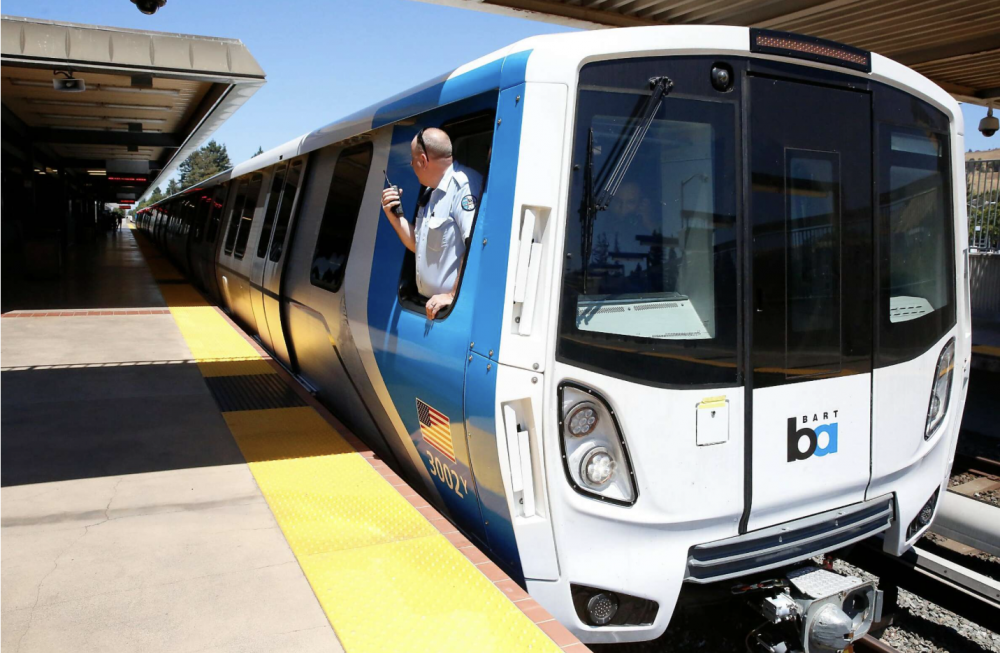
FELIX ZHANG – MARCH 13TH, 2024
EDITOR: SELINA YANG
When BART first started operations in 1972, it was hailed as the transit system of the future. Bay Area Rapid Transit, more commonly referred to as BART, was established with the goal of connecting the growing metropolitan areas of the San Francisco Bay. With frequent service, trains traveling at 70 miles per hour, and efficient routes from suburbs that avoided the traffic of the Bay’s bridges, BART grew to the rapid transit system with the 10th highest ridership in North America, only trailing the systems of larger, older cities. BART had become a quintessential public asset for the commuters of the Bay Area.
Then, the coronavirus pandemic hit.
Overnight, BART ridership plummeted from over 400,000 weekday riders to a mere 20,000. While the initial hope was that the pandemic would subside quickly enough for BART and commuters to return to their usual schedules, it quickly became apparent that this wouldn’t be the case. As lockdowns, regulations, and economic changes persisted from weeks to months to over a year, it became understood that BART, a cornerstone of the Bay Area, would not experience a quick recovery. While transit organizations around the world faced difficulties throughout the pandemic, BART’s bounce back has been significantly slower. In the East Bay, bus agency AC Transit has recovered to nearly 80% of their pre-Covid ridership, and across the similarly sized metro areas of Washington D.C. and Chicago, rail transit ridership has gone back to 62% by August 2023 and 54% by June 2023, of 2019 ridership numbers respectively. As of November 2023, BART’s ridership has only bounced back to 42% of what it was before the pandemic. So how can BART, facing its most uphill financial, social, and cultural challenges, once again become a world class transit system?
The History of BART
The seedlings of BART were born after World War II, as the Bay Area saw a massive boom in economic growth and population. Civic and business leaders recognized the need for a transit system to connect the East Bay with San Francisco as a way to alleviate congestion on the Bay Bridge and mobilize more workers across the entire Bay Area. Passing by just 1.2% in a vote, Bay Area residents elected to approve a $792 million bond issue that would help finance that construction of 71 miles of track. This included the Transbay Tube, which would be the key underwater piece to connecting Oakland and the East Bay to the commercial hub of San Francisco.
The late 1960s and early 1970s saw financial troubles for the still-in-construction system, due to local government challenges and rising inflation rates, but federal grants and supplementary local funding helped the project get off the ground. Mirroring the growth of nearby Silicon Valley, BART became one of the most technologically advanced rapid transit systems in the world, featuring groundbreaking automatic operating systems and train cars that would have easily fit into a sci-fi movie.
Despite the early challenges and setbacks, BART grew to become embedded into the transportation culture of the Bay Area, eventually expanding to five lines and a daily ridership of over 400,000 individuals.
BART post-pandemic
Before the pandemic, BART was seen as a unique beacon of financial independence for a major American transit system. In 2019, the average income from ticket fares for a U.S. transit agency made up just 36% of its operating revenue, with the rest coming from a combination of tax measures and local, state, and federal support. The lack of operating revenue isn’t an inherently bad thing: in fact, the creation of agglomeration effects, reduction in negative externalities such as emissions, and generation of new green jobs and work opportunities provide plenty of reasons to spend public money on transit, with a C40 study finding that every dollar invested in public transit generated five in return – a strong cost-benefit ratio for any type of public project.
However, in the realm of political feasibility, it is often easier for a transit agency to garner additional public support with greater financial independence. BART was in an especially strong position, with their fares accounting for 86% of their total operating revenue in 2019. By 2022, this number had dropped to a measly 17%, 4% below that year’s national average of 21%.
One reason for BART’s current financial struggles was their inability to make changes during the pandemic. Due to both internal and external pressures, BART’s operations during the pandemic remained fairly stable, with few layoffs and changes to service. While operating costs remained at the same level, or even increased, fare revenue plummeted to near-zero levels.
Although high operating costs certainly have contributed to BART’s financial crisis, fundamentally, the biggest challenge that BART has faced post pandemic is low ridership numbers. The national average for transit ridership has bounced back to 80% of what it was before the pandemic: a slow, but steady recovery, as more commuters have gone back to traditional types of work. However, BART’s ridership has only reached the aforementioned meager 42% of what it was in 2019. Why has BART struggled so much compared to the rest of the country?
A specific challenge for BART lies with the slow recovery that the Bay Area has faced since the pandemic. The Bay Area’s high reliance on the technology sector to fuel the economy has led to a particularly difficult recovery from the pandemic. This is largely due to an exodus of workers from the rise of remote work and relocation of companies, where employees moved from the Bay Area to cheaper and more affordable areas of the country, such as Texas, Idaho, and Florida.
Beyond the financial impact, BART has faced concerns about its safety image. A May 2023 survey of Bay Area residents found that 45% of respondents have not returned to BART due to the belief that it is not safe for riders. Violent crime, most commonly robberies, have been up in 2023 compared to the same period in 2022, and have been rising since 2015. Additionally, 79% of riders said that they wanted BART to eject riders who broke the code of conduct, including those doing drugs, drinking, and smoking on the system, with drugs being a particularly large issue on BART’s trains and in its stations. Simply put, to many riders, the BART system is not safe nor clean, dissuading a large portion of its potential users. The culmination of the lack of safety, change in Bay Area commuting and work trends, along with the general national struggle for transit ridership has meant that BART has faced a particularly difficult struggle to a return to its pre-pandemic status.
The Future of BART
It is so crucial that BART survives because a healthy urban fabric relies on a strong transit system. Low income, Black, Hispanic, and Immigrant demographics are the most likely to use public transit, and public transit serves as a crucial source of socioeconomic mobility, expanding the region where individuals can find work, education, and leisure opportunities. Furthermore, public transit is the most effective way to alleviate traffic congestion, improving air quality, reducing noise pollution, and creating a higher quality of life through more walkable urban regions. These positive externalities can’t be captured within BART’s current finances, but could still be economically beneficial for individuals and businesses in the long run by improving community health and equity outcomes.
BART also has been an essential resource for the Bay Area during its best and worst moments. The system recorded its strongest ridership day ever, with over 560,000 exits, during the San Francisco Giants World Series parade in 2012. Meanwhile, during the 1989 Loma Prieta earthquake, which caused a portion of the Bay Bridge to collapse, rendering it unsafe for vehicle travel, BART remained open as a crucial connection between Oakland and San Francisco. BART’s seismic safety measures could be crucial as a lifeline in the future, given the Bay Area’s high potential for earthquakes. Without BART, the region’s ability to celebrate its best moments and persevere through its worst would have been greatly hindered.
While BART’s current financial and ridership situation is dire, there are signs of hope for the agency. BART will receive over $300 million of a $5.1 billion state appropriation for funding public transit, which will help the agency sustain operations through 2024. Additionally, there appear to be other external trends that may positively impact BART’s ridership: the Bay Area sustained population losses from 2019 to 2022, largely thanks to exorbitant housing prices and the pandemic. However, the area is projected to experience a small level of population growth this year. Many individuals and families are still moving out, but the reopening of international immigration from Asia and Central America post-pandemic will largely help stabilize the Bay’s population levels. Additionally, although BART’s weekday ridership has been extremely low, weekend ridership has rebounded to between 60% to 70% of pre-pandemic levels, demonstrating that although BART might not have the same leverage for work commutes, it is likely still used for leisure and event travel.
At the end of the day, in order to continue to receive funding and ridership, BART must prove itself as a reliable transit service, which is contingent on public trust in the agency. As slow as BART has been to adopt changes, it appears as if positive change is on the way. A September 2023 change to service increased frequency on weekends and nights, while decreasing weekday frequency, with BART acknowledging the change in commuting patterns across the Bay Area and the way its service was being utilized. Furthermore, this change came with shorter length of trains and increased onboard police patrols, with the goal of making trains easier to clean and enabling passengers to be closer to staff members in the case of an unsafe situation. Additionally, BART will institute a $90 million renovation of their fare gates across all stations, with the goal of reducing the number of fare evaders, which has cost the agency $30 million annually.
BART has faced unique struggles compared to other transit agencies across the country, but it is not immune from the blame for its poor recovery. At the end of the day, BART riders have made it clear that the system needs to be more reliable, clean, and safe. While it remains to be seen if the changes made by BART will result in a positive impact in its ridership and finances, they are a move in the right direction. While they have been comparatively slow to adapt to a post-Covid world, BART remains the daily core of mobility for thousands of residents. Hopefully, the falling statistics are just a bump in the road in BART’s recovery.
Featured Image Source: SF Gate
Disclaimer: The views published in this journal are those of the individual authors or speakers and do not necessarily reflect the position or policy of Berkeley Economic Review staff, the Undergraduate Economics Association, the UC Berkeley Economics Department and faculty, or the University of California, Berkeley in general.



